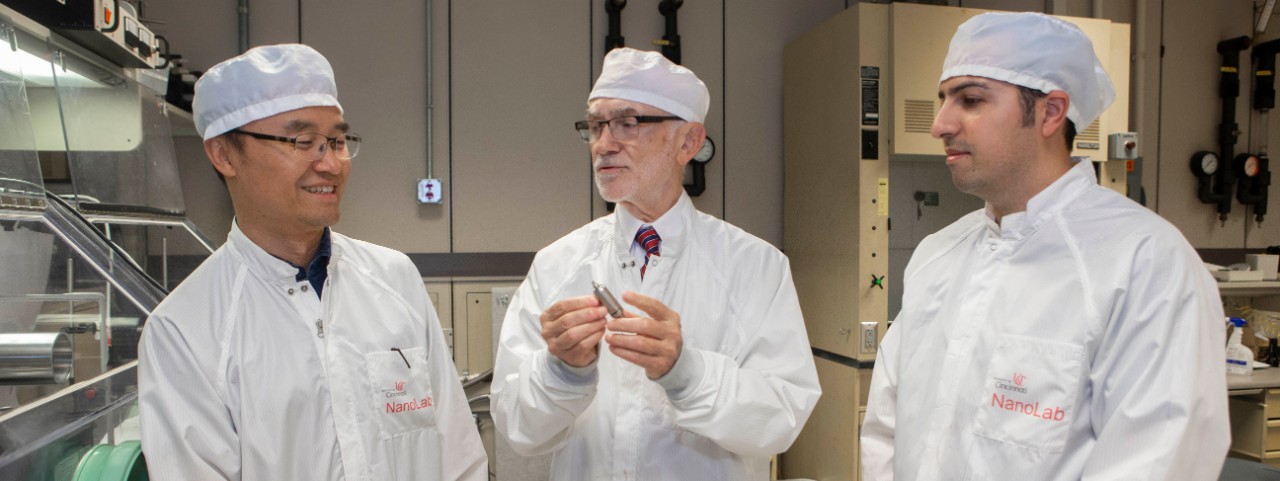
Spectrum News: UC develops new medical apps
Engineering professor Andrew Steckl is developing new applications for the fabrication process
University of Cincinnati engineering professor Andrew Steckl spoke to Spectrum News 1 about promising medical innovations he is developing using century-old technology.
Steckl, a professor of electrical engineering in UC's College of Engineering and Applied Science, is working on new treatments for brain tumors and cancer using a fabrication process called coaxial electrospinning. It combines two or more materials into a fine fiber for use in industry, textiles or even medicine.

Coaxial electrospinning creates a spiderweb-thin fiber. UC is using unique combinations of polymers to develop new medical treatments. Photo/Joseph Fuqua II/UC Creative Services
In the clean room of his Nanoelectronics Laboratory, Steckl creates spiderweb-thin fibers with a core of one material surrounded by a sheath of another. Through unique combinations, he can take advantage of the properties of one material with the powerful benefits of another.
“It’s a bit of complicated physics,” Steckl told Spectrum 1 News. “When you combine the forces of an electric field with the viscous forces of a fluid, you create a very fine jet. It’s stable for a bit and then it becomes unstable and begins to spin around – hence, electrospinning.”
Electrospinning was invented in 1902 for use in textiles. But Steckl has been applying it to medical applications for new drug-delivery systems and novel treatments for a brain tumor called glioblastoma.
Steckl said electrospun pharmaceuticals could release fast-acting painkillers through the outer fiber layer while the inner layer would provide a longer-lasting or slow-release therapeutic drug.
Featured image at top: University of Cincinnati professor Andrew Steckl, center, talks with UC senior research associate Daewoo Han, left, and Turkish researcher Serdar Tort in Steckl's Nanoelectronics Laboratory. Photo/Joseph Fuqua II/UC Creative Services
More news coverage of UC's research
- Science Daily: Electrospun fibers weave new medical innovations
- The Verdict: The 100-year-old manufacturing technique set to revolutionize medicine
- SciTechDaily: Not Spiderwebs: These Electrospun Fibers Weave New Medical Innovations
- MedGadget: Coaxial Electrospinning Creates Novel Contraceptive, Other Devices
Become a Bearcat
- Apply online or get more information about undergraduate enrollment by calling 513-556-1100.
- Learn more about UC's many undergraduate and graduate programs.
Related Stories
We love ‘Lucy’ — the AI avatar redefining UC tech transfer
July 17, 2024
In a visionary leap at the University of Cincinnati, the marriage of artificial intelligence and interactive technology has birthed "Lucy," a Smarthelp AI avatar poised to revolutionize how regional industries engage with UC's tech transfer initiatives.
NIS program opens new horizons for international student
July 17, 2024
In his pursuit of physics and a taste for research, Akash Khanikor ventured from his hometown in India's Assam to the University of Cincinnati, drawn by the promise of hands-on exploration early in his undergraduate career as a NEXT Innovation Scholar.
Camp aims to empower children, teens who stutter
July 17, 2024
A one-week, evidence-based program for children and teens who stutter at the University of Cincinnati will teach kids to communicate effectively, advocate for themselves and develop confidence about their communication abilities. Camp Dream. Speak. Live., which is coming to Cincinnati for the first time July 22-26, began in 2014 at the University of Texas at Austin. The Arthur M. Blank Center for Stuttering Education and Research at UT expects to serve more than 2,000 children at camps across the United States, Africa, Asia and Europe this year.

